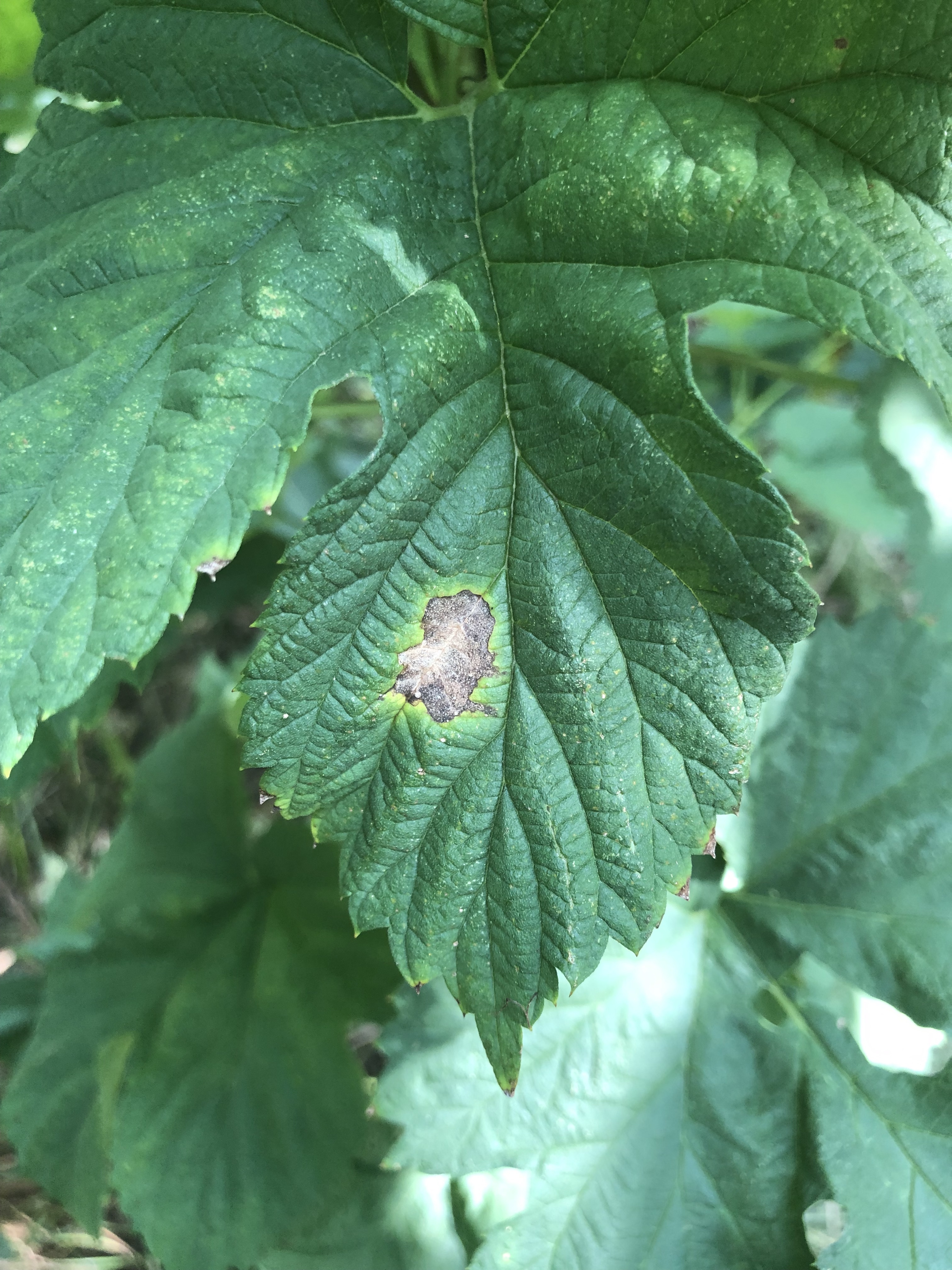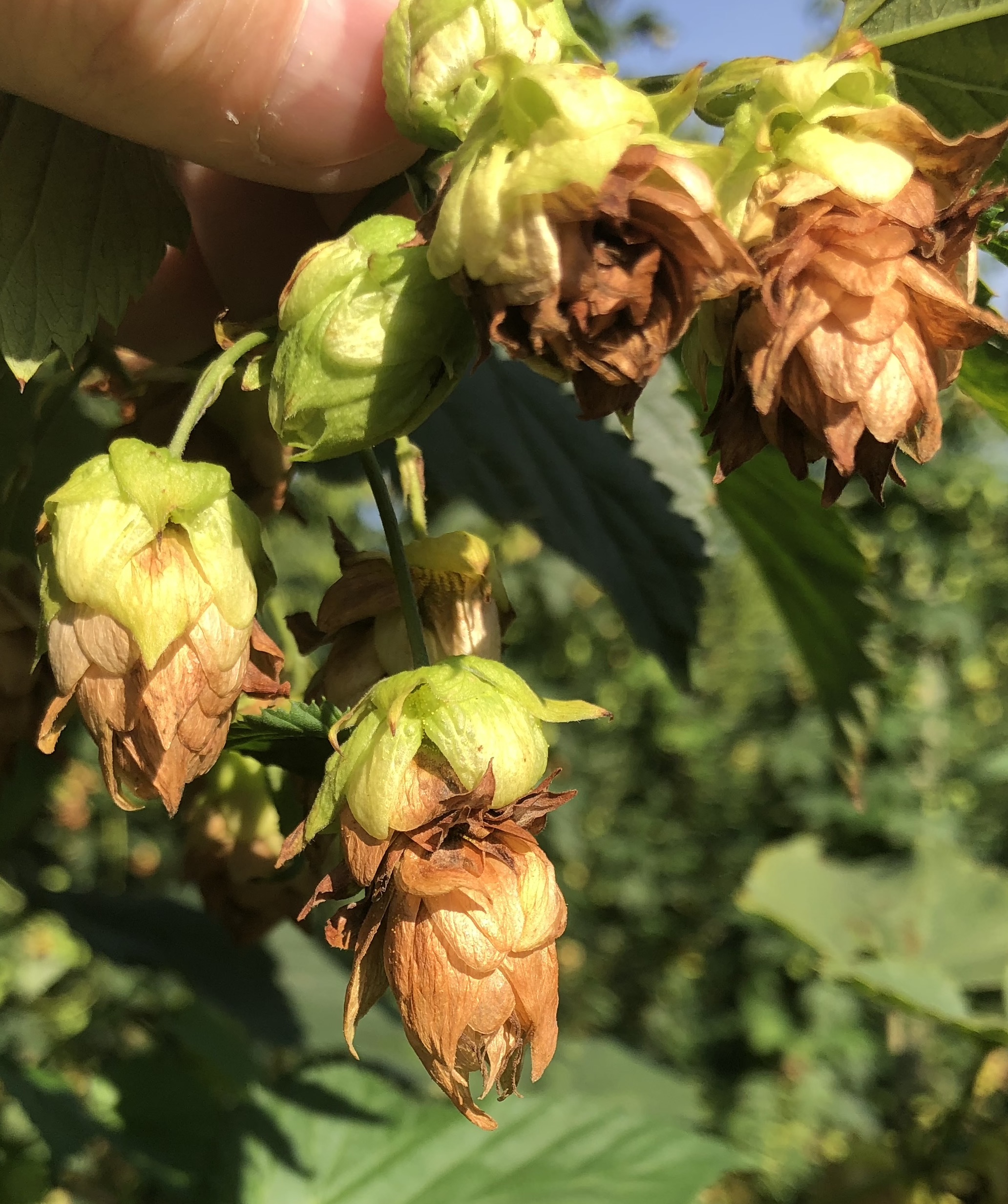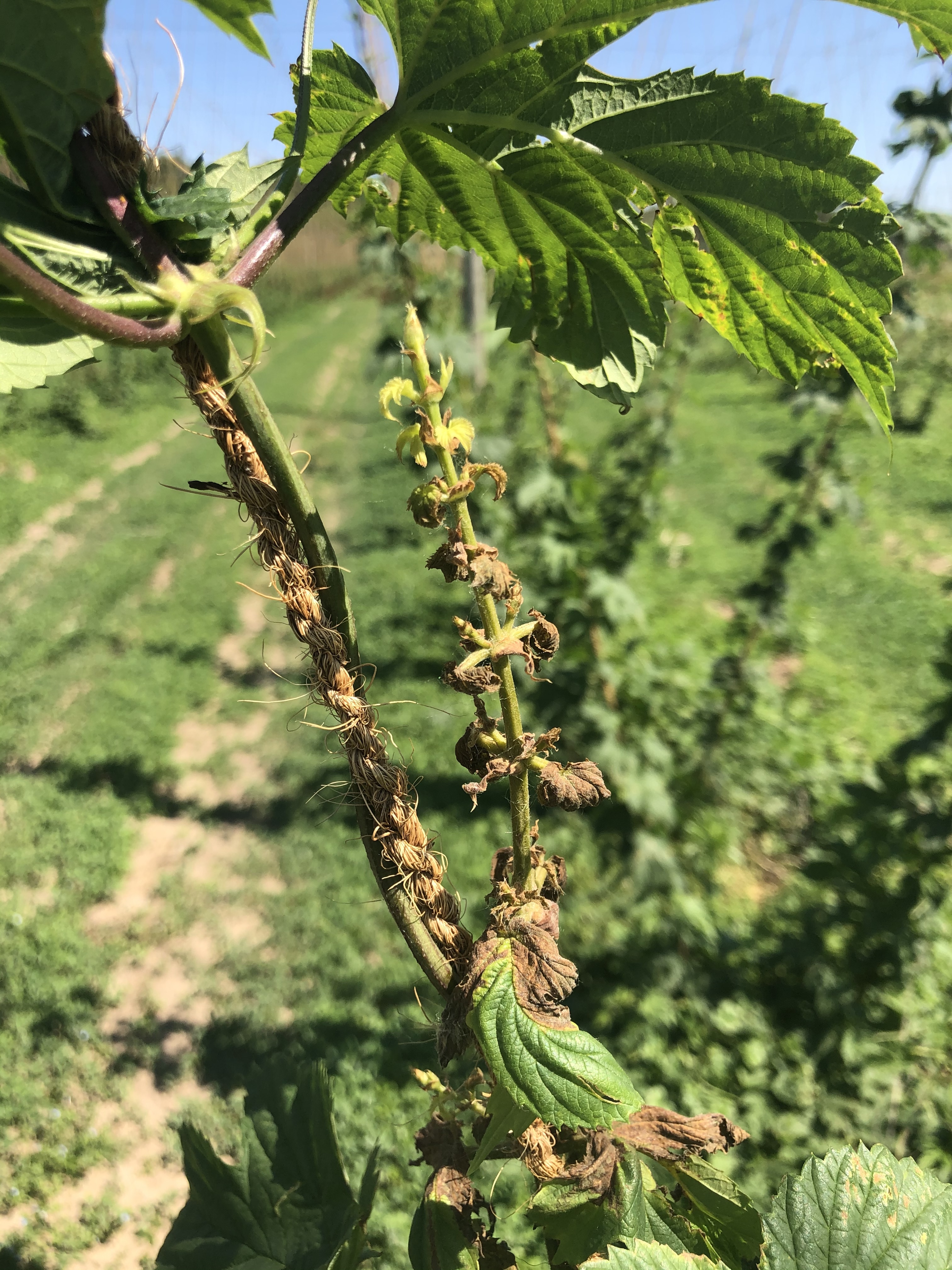MSU research examining ways to control destructive hop diseases
Overcoming issues in a rapidly emerging Michigan industry
The bustling craft brew scene in Michigan helped inspire hop farming in the state some 15 years ago. Suddenly there was a draw to producing the cone-shaped flowers grown on high trellises and eventually dried to give beer its distinct bitterness and aroma.
It marked the start of a new industry. Michigan went from harvesting zero acres of hops in 2012 to some 300 the next. By 2017, there were more than 800 acres harvested, according to Hop Growers of America (HGA).
But a quickly saturated market, complicated by COVID which caused some bars and restaurants to close and ultimately resulted in supply chain issues, prompted some hop producers to rethink their investments. By 2021, the number of Michigan hops harvested fell to less than 400 acres – according to the latest HGA survey.
Despite a somewhat turbulent start, Michigan is the fourth largest hop producer in the U.S. It trails Idaho, Oregon and Washington, yet is the primary hop grower outside the Pacific Northwest.
It’s an industry Michigan State University plant pathologist Timothy Miles believes has stabilized since its rapid ascent a decade and a half ago.
“Michigan’s hop industry grew the biggest and the fastest of all the states. We nearly reached 1,000 acres – which is a lot of hops actually,” he said. “Then a lot of the smaller size growers left. Now we have what I feel is a more stable industry. People who have really invested in it and they’re managing hop production very well.”
Many credit Miles, an assistant professor in the Michigan State University Department of Plant, Soil and Microbial Sciences and MSU AgBioResearch scientist, and his MSU colleagues for helping to meet the vast demands of hop production.
Establishing a hop yard in a humid, wet state like Michigan demands a jostling of hands-on tasks. Hops take three years to produce a full harvest and reach maturity. They grow on 20-foot trellises and training the bines – the flexible stems of the plant – to climb the attached strings requires diligence. Not to mention a lot of pruning, and fending off disease.

“Hops are really difficult to manage and to grow particularly in Michigan where the weather is wetter and more humid throughout the growing season compared to that in the leading Pacific Northwest producing states,” said Miles.
Until a couple of years ago, the primary threat to hop production in the Great Lakes region had been downy mildew. The disease caused by a fungus-like organism called Pseudoperonospora humuli thrives in wet, humid growing seasons and can result in significant yield and quality losses depending on the variety and time of establishment.
Downy mildew presents primarily as fuzzy spore masses with the underside of leaves turning black in color, although appearances may vary slightly based on variety and timing. The disease does overwinter so early spring pruning can help to eliminate infected buds and remnants from the prior season. Pruning is also critical to increase airflow and light, helping to eliminate the chance of development of the disease which is most serious during wet and mild temperatures.
If infected bines grow and new tissue develops, the likelihood of spread is significant and decreases the ability of the new growth to climb the trellises. There is the chance to retrain new shoots, but yield losses are likely to incur.
Over recent years, however, Michigan hop growers have been equipped to address downy mildew, and even overcome it. Research from MSU, including annual Extension publications, has revealed what cultivars are more tolerant than others to the disease, and what fungicides are most effective in treating it. Perhaps most compelling is that growers now have tools to scout for it and diagnose it.
While providing guidance and practices on downy mildew has moved the needle, Michigan hop growers face yet another disease. One that sounds benign enough – halo blight - but poses challenges.
First reported in Michigan in 2018, the fungal disease spoils hop cones and is geographically unique in that it doesn’t impact the high hop producing states of the Pacific Northwest. While there is still a lot yet to learn about halo blight in Michigan, MSU advancements are already making significant impacts.

Rick Kawalski is the senior manager of farm operations at Hop Head Farms, LLC in Hickory Corners, Michigan. The MSU alum first gained interest in hop production as an intern for Yakima Chief Ranches in Washington. He says Miles and the work of MSU on halo blight has been particularly vital to Hop Head.
“The research Tim is doing has benefited our farm and the Midwest in many ways. In my opinion, the halo leaf blight research has been the most instrumental in turning our farm around,” said Kawalski. “With the disease being brand new to hops and not having any treatment recommendations, most Midwest growers were dead in the water and losing as much as 50% of yields to it.”
Miles is quick to credit MSU Department of Plant, Soil and Microbial Scientist Mary Hausbeck and her former doctoral student Doug Higgins, now working at Virginia Tech, for laying the scientific groundwork on halo blight. They collaborated knowing they were starting from ground zero on a potentially devastating pathogen.
“Almost all of the field plots we’ve set up now are more related to halo blight rather than downy mildew,” said Miles. “It’s an evolving situation. [Growers] get one disease managed and then they have to deal with another one.”
Julie Kane, greenhouse grower with Sandy Ridge Farms Inc. in Zeeland, knows the importance of supplying growers plants free of diseases such as downy mildew and halo blight. The greenhouse has been supplying hop plants to the industry for 14 years and has relied heavily on the experience of Miles and MSU in general.
“Right from the very beginning we’ve been involved with MSU, providing hop plants for their research and sharing that data with our growers. It was an industry that hadn’t been in the Midwest for hundreds of years and we needed instruction from them,” Kane said. “It’s been a very natural fit for us. Determining the most effective chemicals against specific pathogens, the timing of those applications, scouting and providing resources because we’re often the ones getting the first calls from growers.”
Kane said scientific advancement sometimes means sacrificing healthy plants from greenhouses like hers to determine industry results from MSU experts.

“We sometimes joke that ‘hey, we’re giving you these healthy baby plants and then the researchers are excited to inoculate them with downy mildew or powdery mildew’ but that’s part of the back-and-forth and the information exchange,” she said.
Miles realizes the irony in Kane’s comment. As a diligent plant pathologist, Miles said he has to remain focused on the pathogens over the plants.
Halo blight is his current focus and the conversation of late among the hop industry. Miles is working with MSU colleagues to provide answers and combat the disease. His previous experience and knowledge addressing grape production, a crop with similar diseases, has helped.
“When Tim took on hop research, he quickly had some cultural ideas for control due to his familiarity with a similar pathogen in grapes,” said Kawalski. “He then continued with the fungicide efficacy trials to find out if anything labeled for hops would work on halo blight. This was important for us especially since the Pacific Northwest wasn't also experiencing this disease.”
For Kawalski, with input from MSU -- he’s been able to adjust his integrated pest management program and focus on chemistries that seem most critical for preventing yield loss, such as during the bloom and post-bloom periods. This, coupled with pruning dead residue from the previous year has allowed for higher hop yields and great quality this past year, he said.
Miles said industry support from folks such as Kawalski and Kane has been invaluable. And while he might not have what he calls the ‘silver bullet’ for halo blight now, he plans to continue bouncing what he learns off of those in the field.
Additional background on hops and Mary Hausbeck, a MSU distinguished professor and associate chairperson of the Department of Plant, Soil, and Microbial Sciences.
The first thing Mary Hausbeck noticed is that Michigan hop growers did not have the newest fungicide tools to combat downy mildew on the crop. Immersed in managing the sister species to the hop downy mildew, Pseudoperonospora cubensis on cucumber, she was familiar with the fungicides that could help. Hausbeck was successful in garnering a Section 18 emergency exemption for the use of Presidio (fluopicolide) fungicide for Michigan hop growers. EPA’s initial response was that Michigan growers shouldn’t try to grow hops in the state because downy mildew has been a historical disease problem from more than 100 years ago. Her argument was that the availability of new effective fungicides could protect the crop and the state’s fledgling industry deserved a fighting chance. Eventually, she prevailed and was able to advance the control program for downy mildew in the state.
Hausbeck also submitted a pesticide clearance request for the USDA IR-4 Project for the registration of another highly effective downy mildew fungicide called Orondis (oxathiapiprolin) for which she had garnered the preliminary information needed to convince the registrant that this was an effective use. This was notable because the Pacific northwest hops production states historically steered the IR-4 priorities for the crop. The year that she put forward oxathiapiprolin caused quite a stir. Given that she had good data and a long history with the IR-4, both her priority for oxathiapiprolin and the Pacific northwest’s priority for an insecticide were both advanced.
When Doug Higgins started in Hausbeck’s program, there were no data regarding the cultivar susceptibility or the efficacy of fungicides against downy mildew. Her program established a non-trellised hop research field at the Plant Pathology Research Farm and at the Southwest Michigan Research and Extension Center. Both studies have been published by her lab. It was during Higgin’s time in the Hausbeck lab that the new pathogen came to light. Dr. Jan Byrne in MSU’s Diagnostic Clinic was the first to discover this. Higgins then switched his thesis research to focus on this emerging pathogen (Diaporthesp.) of hop associated with foliar necrosis in commercial production yards in Michigan. It was around this time that Tim Miles arrived at MSU and the hops pathology program reverted to that program. Collaboratively, they then worked as a group during the transition.
Key hops deliverables from the Hausbeck lab:
- Section 18 Emergency Exemption for an important and effective downy mildew fungicide.
- A priority from the USDA IR-4 Program for a new downy mildew fungicide that received registration.
- Identification of hops cultivars that are less susceptible to downy mildew and effective fungicides to guide growers.
- Identification of a new pathogen of hops.
- Excellent training of a PhD student in extension and research who received a faculty job offer upon his first interview.



 Print
Print Email
Email




